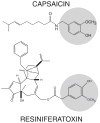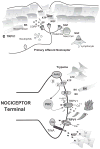Transient receptor potential channels in pain and inflammation: therapeutic opportunities
- PMID: 20230457
- PMCID: PMC3112370
- DOI: 10.1111/j.1533-2500.2010.00358.x
Transient receptor potential channels in pain and inflammation: therapeutic opportunities
Abstract
In ancient times, physicians had a limited number of therapies to provide pain relief. Not surprisingly, plant extracts applied topically often served as the primary analgesic plan. With the discovery of the capsaicin receptor (transient receptor potential cation channel, subfamily V, member 1 [TRPV1]), the search for "new" analgesics has returned to compounds used by physicians thousands of years ago. One such compound, capsaicin, couples the paradoxical action of nociceptor activation (burning pain) with subsequent analgesia following repeat or high-dose application. Investigating this "paradoxical" action of capsaicin has revealed several overlapping and complementary mechanisms to achieve analgesia including receptor desensitization, nociceptor dysfunction, neuropeptide depletion, and nerve terminal destruction. Moreover, the realization that TRPV1 is both sensitized and activated by endogenous products of inflammation, including bradykinin, H+, adenosine triphosphate, fatty acid derivatives, nerve growth factor, and trypsins, has renewed interest in TRPV1 as an important site of analgesia. Building on this foundation, a new series of preclinical and clinical studies targeting TRPV1 has been reported. These include trials using brief exposure to high-dose topical capsaicin in conjunction with prior application of a local anesthetic. Clinical use of resiniferatoxin, another ancient but potent TRPV1 agonist, is also being explored as a therapy for refractory pain. The development of orally administered high-affinity TRPV1 antagonists holds promise for pioneering a new generation of analgesics capable of blocking painful sensations at the site of inflammation and tissue injury. With the isolation of other members of the TRP channel family such as TRP cation channel, subfamily A, member 1, additional opportunities are emerging in the development of safe and effective analgesics.
Figures




References
-
- Appendino G, Szallasi A. Euphorbium: modern research on its active principle, resiniferatoxin, revives an ancient medicine. Life Sci. 1997;60:681–696. - PubMed
-
- Fields HL. Pain syndromes in neurology. London, Boston: Butterworths-Heinemann Ltd; 1990.
-
- Carpenter MB. Core text of neuroanatomy. 3. Baltimore: Williams & Wilkins; 1985.
-
- Cervero F. Sensory innervation of the viscera: peripheral basis of visceral pain. Physiol Rev. 1994;74:95–138. - PubMed
-
- Janig W, Khasar SG, Levine JD, Miao FJ. The role of vagal visceral afferents in the control of nociception. Prog Brain Res. 2000;122:273–287. - PubMed
Publication types
MeSH terms
Substances
Grants and funding
LinkOut - more resources
Full Text Sources
Medical

